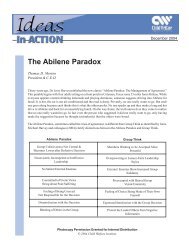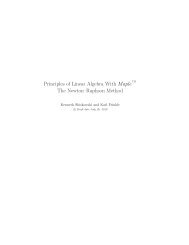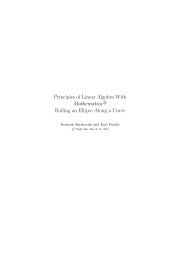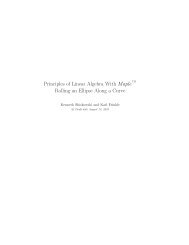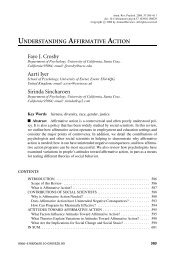www.SE.edu 1-800-435-1327 - Southeastern Oklahoma State ...
www.SE.edu 1-800-435-1327 - Southeastern Oklahoma State ...
www.SE.edu 1-800-435-1327 - Southeastern Oklahoma State ...
Create successful ePaper yourself
Turn your PDF publications into a flip-book with our unique Google optimized e-Paper software.
122 <strong>Southeastern</strong> <strong>Oklahoma</strong> <strong>State</strong> University<br />
PRENURSING<br />
There are two nursing programs which lead to certification<br />
as a Registered Nurse (R.N.). Consequently, <strong>Southeastern</strong><br />
offers two pre-nursing programs.<br />
Two-Year Program<br />
The two year program offered by junior colleges provides<br />
the graduate with an Associate of Science degree in addition<br />
to the opportunity to obtain R.N. certification. Courses which<br />
may be taken at <strong>Southeastern</strong> and applied to the junior college<br />
program include English (two semesters), sociology (one<br />
semester), psychology (one-two semesters), nutrition (one<br />
semester), human anatomy (one semester), human physiology<br />
(one semester), and microbiology (one semester).<br />
Four-Year Program<br />
Four year nursing programs offered by senior colleges and<br />
universities provide the graduate with a Bachelor of Science<br />
degree in addition to the opportunity to obtain R.N. certification.<br />
Courses which may be taken at <strong>Southeastern</strong> during the<br />
first two years of prenursing include English (two semesters),<br />
American history (one semester), American government (one<br />
semester), general chemistry (one-two semesters), nutrition<br />
(one semester), general zoology or introductory biology course<br />
for majors (one semester), microbiology (one semester), human<br />
anatomy (one semester), human physiology (one semester),<br />
psychology (one-two semesters), sociology (one semester),<br />
statistics (one semester), and other related courses.<br />
For additional information, contact the Department of<br />
Biological Sciences.<br />
PREOCCUPATIONAL THERAPY<br />
To be considered for admission to Occupational Therapy<br />
programs at most universities, a candidate must (a) have<br />
completed 64-90 semester hours of pre-professional collegiate<br />
credit with a minimum GPA of 2.75, (b) have a minimum<br />
grade of “C” in all prerequisite courses, (c) have documentation<br />
of observation experience. In addition, the candidate may<br />
be required to take the Allied Health Professions Admissions<br />
Test (AHPAT).<br />
The prerequisite courses may include English (two-three<br />
semesters), speech (one semester), American history and<br />
government (two semesters), statistics (one semester), medical<br />
terminology (one semester), psychology (two-four semesters),<br />
physics (one-two semesters), human physiology and anatomy<br />
(two semesters).<br />
For additional information, contact the Department of<br />
Biological Sciences.<br />
PREOPTOMETRY<br />
Most programs recommend a B.S./B.A. in science (chemistry,<br />
biology, or interdisciplinary medical sciences degree) for<br />
admission. All of the entering students at NSU and UT had a<br />
B.S./B.A. upon admission.<br />
The course work to be completed at time of application<br />
to the optometry program includes general chemistry with<br />
laboratory (CHEM 1315 and CHEM 1415); physics with laboratory<br />
(PHYS 1114 or 2014 and PHYS 1214 or 2114); organic<br />
chemistry with laboratory (CHEM 3053/3062); biochemistry<br />
(CHEM 4115); Principles of Biology I and II with laboratory<br />
(BIOL 1404 and 1504), microbiology (BIOL 2114); English<br />
grammar and composition (ENG 1113 and 1213), requires “C”<br />
or higher; mathematics (6 semester hours), including college<br />
algebra (MATH 1513) and trigonometry (MATH 1613), however,<br />
calculus (MATH 2215) is required at several optometry<br />
programs; statistics (STAT 2153); psychology (PSY 1113).<br />
Other courses which are strongly recommended include human<br />
anatomy (BIOL 3614) and human physiology (BIOL 3624),<br />
social sciences, humanities, public speaking (COMM 2213),<br />
analytic geometry (MATH 2113), computer science (CIS 1003),<br />
accounting (ACCT 2103), and experimental psychology (PSY<br />
3433). The applicant must take the Optometry Admission Test<br />
(OAT), and scores must be submitted to the optometry program<br />
prior to application. The OAT should be taken the fall semester<br />
before you plan to apply. A minimum GPA of 2.5/4.0 or higher<br />
is required for all U.S. optometry programs.<br />
The same requirements will generally apply to other<br />
schools of optometry, however these specific requirements<br />
only address the program at Northeastern <strong>Oklahoma</strong> <strong>State</strong><br />
University.<br />
For additional information, contact the Department of<br />
Chemistry, Computer, and Physical Sciences and visit the Association<br />
of Schools and Colleges of Optometry at <strong>www</strong>.opted.<br />
org and choose “About Optometric Education” for more details<br />
about optometry as a career.<br />
PREOSTEOPATHIC MEDICINE<br />
Most colleges of osteopathic medicine have a prerequisite<br />
of three years or 90 semester hours of college course work;<br />
however, the majority of students who are admitted will have<br />
received their bachelor’s degree upon entry. Students interested<br />
in preosteopathic medicine are encouraged to meet with<br />
an advisor as soon as possible to determine a major/minor<br />
program. It is important to understand that a student may major<br />
in any discipline as long as the minimum requirements for<br />
admission are met.<br />
Coursework should include the following: English (ENG<br />
1113 & 1213), general chemistry I & II with lab (CHEM 1315<br />
& 1415), organic chemistry I & II with lab (CHEM 3053, 3153,<br />
3062 & 3162), physics I & II with lab (PHYS 1114 & 1214), and<br />
principles of biology I (BIOL 1404). In addition, at least 4 more



